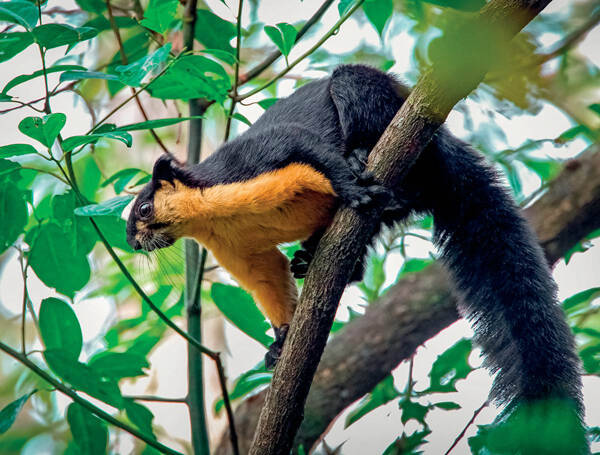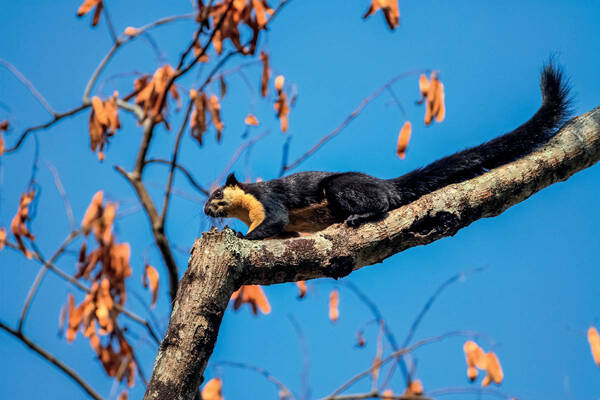Ratufa bicolor
IUCN
LCBasic Information
Scientific classification
- name:Ratufa bicolor
- Scientific Name:Ratufa bicolor(Sparrman, 1778),Black Great Squirrel,Tree dog, black civet, vine civet, black civet, black giant squirrel or Malayan giant squirrel
- Outline:Rodents
- Family:Rodentia Sciuridae G.squirrel
Vital signs
- length:35~40cm
- Weight:1-3kg
- lifetime:
Feature
The largest arboreal squirrel.
Distribution and Habitat
Distributed in Yunnan, Guangxi and Hainan in China. Distributed abroad in India, Nepal, Malaysia, Indochina, Indonesia, etc.
Lives on tall trees in tropical rainforests and monsoon forests.
Appearance
The body is slender and good at climbing. The ears are prominent and have long tufts of hair, the edges of the lower jaw and eye sockets are black, and there are two long black spots on the chin. The color of the fur on the back of the body is black, reddish black, red, dark brown or grayish brown. The abdomen is white, or white mixed with brown, or orange. The front feet are wide, and the insteps of the front and rear feet are black. The tail is long and fluffy. The skull is thick and strong, and the front end of the nose bone is curved downward.
Details
Giant squirrels are large rodents that live in high trees in tropical and subtropical monsoon forests below 2,000 meters above sea level. They are typical arboreal animals.
Giant squirrels prefer to live alone and rarely live in groups. Occasionally, 2 to 3 of them are seen feeding on the same tree. Giant squirrels are active during the day, with an activity radius of about 2 to 3 kilometers. Before 10 a.m. and after 4 p.m. to dusk are the most active times of the day. They usually rest on high trees around noon. They are alert and will quickly climb branches and escape if they are slightly startled. They have strong jumping ability and can jump over branches 2 meters apart. [6] No one has ever been seen running away, unless they are hit and fall to the ground, then they will hide in cracks in rocks or piles of trees. When the weather changes, such as windy, rainy or foggy, they rarely come out to move around. They also leave the nest later after rain.

They feed purely on plants, with a variety of tree fruits as their staple food. In seasons when fruits are scarce, they also eat young leaves and stamens of plants. For example, in spring, when their stomachs were dissected, green objects and stamens were found. In summer and autumn, there are more fruits, which are chewed carefully, and only the flesh is eaten. Fruit shells and fruit cores have never been found in their stomachs. In areas where giant squirrels are active, there are often a large number of peels and fruit shells that they have gnawed and discarded under fruit trees. When feeding, it uses its front paws to pick fruits, hold them or hold them down to bite them, and its movements are flexible and free. An adult giant squirrel eats 200-300 grams each time, and eats twice a day, eating about 500 grams of fruit.
Giant squirrels are typical arboreal animals, living in nests. The nests are built on treetops or high branches above 20 meters, and are made of dead branches or dry leaves. The branches vary in thickness, the structure is rough, and they are oval. The diameter of the nest is mostly above 330 mm, and it is rare to live in a tree hole.

It can reproduce twice a year, but estrus and mating are more concentrated in spring, and birth is more concentrated in summer. The gestation period lasts 28 to 35 days, and 1 to 3 pups are born per litter.
The population of giant squirrels has decreased significantly over the past decades, and has become extinct in many places. Previous documents record that specimens were collected in Nanfeng, Danxian, but they are no longer seen today. There were many in the Yabingbawang forest area of Baisha before 1958, but they are rare now. In 1960, the Hainan Bird and Animal Survey Team conducted a survey in Yajia and Baijing and found that they were still common. Now, as the environment near the forest farm gradually changes, the population has greatly decreased.

In 1979, it was included in the list of China's national key protected wild animals and was designated as a national Class II key protected wild animal. Illegal hunting and trade are prohibited. In addition to basic measures such as hunting bans, habitat protection and trade restrictions, several zoos have been breeding them since 1978.
Listed in the second level of the "List of National Key Protected Wildlife in China".








